Table 105. - Liveweight gain data from pastures under coconuts, Western Samoa (Robinson, 1981)
| Treatment/Species | Gain (kg ha-1) | Stocking Rate steers ha-1) | |
| Trial 1 (365 days) | |||
| Local | 466 | 4.0 | |
| Batiki | 495 | 4.0 | |
| Palisade | 533 | 4.0 | |
| Cori | 541 | 4.0 | |
| Para | 511 | 4.0 | |
| Tall Guinea | 491 | 4.0 | |
| Trial 2 (365 days) | |||
| Local | 401 | 4.0 | |
| Batiki | 505 | 4.0 | |
| Palisade | 693 | 4.0 | |
| Cori | 744 | 4.0 | |
| Para | 421 | 4.0 | |
| Tall Guinea | 724 | 4.0 | |
Note: Most of the legume mixture of Siratro and Centro failed to persist, the
legume component was taken over by Sensitive plant (Mimosa pudica),
which was also dominant in non-fertilized local pastures.
Para grass also failed to persist and this treatment can be regarded under
Trial 2 period as fertilized local.
Fertilizer use: as described in Tables 50 and 51
Trial period: 1) 1978–1979, 2) 1979–1980
Trial carried out under coconut palms 50–70 years. old, spaced 9.1 m2 with
a light transmission of 70–84 percent.
On these fertile soils sown grass species established well initially, but then declined due to severe competition from Puero during establishment, preferential grazing by cattle and smothering of the weakened grass plants by the climbing Puero. Although the available green dry matter on offer showed no difference between the two pasture types at any stocking rate, the natural and introduced pastures had very different species compositions. At any level of dry matter, natural pastures produced slightly superior liveweight gains head-1. Figure 168 shows that most of the data points for natural pasture are above the common line for the relationship, while those for the Puero dominant introduced pastures are below the line. The differences may be in the legume quality; Puero palatability may be influenced by time of year (Smith and Whiteman, 1983b). The two authors concluded that:
Sown Brachiaria species will not persist in mixed grass legume swards grazed under either a continuous or rotational “28 day in - 28 day out” system.
Under the rotational grazing system used liveweight gains head-1 and ha-1 were slightly lower on natural pastures under coconuts giving 60 percent light transmission compared to continuous grazing.
Shading may reduce grass quality.
Grass dry matter production has a direct linear relationship with light transmission percentage.
For maximum liveweight gains ha-1, pastures should be stocked at approximately 3.6 animals ha-1 (as the animals used were approximately 0.55 animal units (AU), this is equivalent to about 2.0 AU ha-1). A stocking rate of 2.5 animals ha-1 (or 1.4 AU ha-1), will give better animal-1 gains and reduced stock numbers and costs without large losses in liveweight gains ha-1.
Table 106. - Effects of pasture and stocking rate on liveweight gains over three years grazing on sown and natural pastures under coconuts, Solomon Islands (Watson and Whiteman, 1981a)
| Pasture | Stocking Rate (no. of animals ha-1) | Year 1 | Year 2 | Year 3 | |||
| head (kg day-1) | ha (kg yr-1) | head (kg day-1) | ha (kg yr-1) | head (kg day-1) | ha kg yr-1) | ||
| Sown* | 1.5 | 0.50 | 275 | 0.47 | 255 | 0.23 | 123 |
| 2.5 | 0.43 | 388 | 0.37 | 333 | 0.23 | 210 | |
| 3.5 | 0.34 | 437 | 0.30 | 379 | 0.18 | 229 | |
| Natural** | 1.5 | 0.52 | 282 | 0.48 | 263 | 0.29 | 158 |
| 2.5 | 0.46 | 422 | 0.41 | 376 | 0.23 | 208 | |
| 3.5 | 0.34 | 428 | 0.32 | 411 | 0.15 | 195 | |
| S.E. | 0.02 | 14 | 0.02 | 21 | 0.02 | 33 | |
S.E. for comparing stocking rates within pasture.
* A mixture of B. mutica, B. decumbens and B. humidicola with Centro, Puero and Stylosanthes guianensis (all grasses grazed out after a year of set stocking).
** Main species present: Axonopus compressus, C. pubescens, M. pudica, Calopogonium mucunoides;
Minor species: P. conjugatum, D. heterophyllum, D. canum, P. phaseoloides, Synedrella nodiflora, Borreria sp., Peperomia pellucida and Mikania sp.
(All pastures fertilized with 20 kg P, 50 kg K, 20 kg S and 0.16 kg molybdenum ha-1 at the start as a basal dressing. Mean annual rainfall - 2,900 mm. Trials carried out under coconut palms (Federated Malay States variety) at an 8.2 m triangular spacing giving 170 trees ha-1 with a mean light transmission of 60%.)
Table 107. - Effect of stocking rate and pasture type on final animal weight after two years grazing (Watson and Whiteman, 1981a)
| Stocking Rate (number of animals ha-1) | Liveweight (kg animal-1) | |
| sown pasture | natural pasture | |
| 1.5 | 385 | 414 |
| 2.5 | 354 | 370 |
| 3.5 | 308 | 303 |
Table 108. - Liveweight gains of weaner steers grazing natural and introduced pastures at three stocking rates under coconuts, Solomon Islands (Smith and Whiteman, 1983b).
| Pasture | Stocking Rate (no. of animals ha-1) | 1980–81 | 1981–82 | 1982–83 | |||
| head (kg day-1) | ha (kg yr-1) | head (kg day-1) | ha (kg yr-1) | head (kg day-1) | ha b(kg yr-1) | ||
| Natural | 1.5 | 0.40a | 217b | 0.38a | 209bc | 0.43a | 237bc |
| 2.5 | 0.32bc | 288a | 0.33a | 302a | 0.40ab | 363a | |
| 3.5 | 0.26c | 336a | 0.27a | 343a | 0.24c | 311ab | |
| Mean | 0.32x | 280x | 0.33x | 285x | 0.36x | 303x | |
| Sown | 1.5 | 0.37ab | 205b | 0.32a | 174c | 0.36ab | 195c |
| 2.5 | 0.31bc | 286a | 0.26a | 241b | 0.27c | 250bc | |
| 3.5 | 0.25c | 324a | 0.18b | 234b | 0.25c | 313ab | |
| Mean | 0.31x | 271x | 0.26x | 216y | 0.28y | 264y | |
Note: Means or gains in any column followed by the same letter are not significantly different (P<0.05).
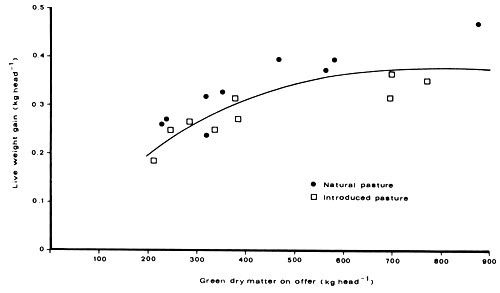
Figure 168. - Relationship between liveweight gain head-1 and green DM head-1 on offer (Smith and Whiteman, 1983b).
An indication of the effect of shading on liveweight gains ha-1 is given by using data from this trial and data reported by Watson and Whiteman (1981a). Soils at this site and that used by Smith (1983) on the Guadalcanal Plains for open pasture are quite fertile. Levels of maximum production at this site (340–440 kg liveweight gain ha-1) are some 50–70 percent of the levels (600–700 kg liveweight gain ha-1) recorded from superior open pastures on Guadalcanal Plains. Light transmission percentage at this site was 80 percent which must account mainly for the difference in production (Smith and Whiteman, 1983a). This is not unexpected as Whiteman (1980) has already noted that in savanna and open woodland, yields of pasture were closely related to the thinning or removal of trees (Gillard, 1970; Walker et al., 1972). The levels of animal production were also related to tree density in oversown grasslands (Williams and Gillard, 1971). Wahananiu et al. (1993) note that good pastures under coconuts (in the Solomon Islands) have a carrying capacity of only 40% of open pasture.
Manidool reported (1983) on cattle grazing Signal grass-Centro pastures under coconuts in Thailand. Animals were grazed at three stocking rates - 1.0, 1.5 and 2.5 head ha-1, with an additional paddock of unimproved pasture grazed at 1.0 head ha-1. Fertilizer (15-15-15) at 625 kg ha-1, split into 5 applications, was applied to all paddocks and the trial lasted for two years. Animals grazing the improved pastures, produced more than twice the weight gain of those grazing the native pasture at the same stocking rate (see Table 109). Manidool concluded that the Signal grass-Centro pastures could support up to 2.5 head ha-1 without requiring supplementary feed but the best stocking rate appeared to be 1.5 head ha-1.
In trials with rubber in Thailand, sown species could not tolerate the dense shade in four year old rubber and were invaded by native species (Manidool, 1985).
In Sri Lanka, Liyanage et al. (1989) and Liyanage (1993) reported liveweight gains of 306 g head-1 day-1 over a one year period on their model integrated unit (under coconuts) stocked at approximately 4 (Jersey × local cross bred) heifers ha-1 with average heifer liveweight increasing from an initial weight of 70 kg (at six months of age) to 200 kg when grazed on B. miliiformis/P. phaseoloides and loppings of Gliricidia and Leucaena but no concentrates (except for some additional urea treated rice straw in dry periods). Where gliricidia leaves were fed with B. miliiformis at a ratio of 50 : 50 to Jersey × local heifers, daily liveweight gains of 700 g head-1 were produced during the wet season (Liyanage and Wijeratne, 1987). In the coconut triangle sheep can be stocked at 5–15 ewes ha-1 yr-1 and carcass weights of 13.5 kg obtained at 12 months (Jayawardana, 1988). Breeds tried have been Bannur and Red Madras.
Table 109. - Weight gain of cattle grazing native and Signal grass-Centro pastures in Choomphon, Thailand (Manidool, 1983)
| Stocking Rates head ha-1 | Type of pasture | Weight gain kg ha-1year-1 | |
| 1979 | 1980 | ||
| 1.0 | Native | -- | 43.7 |
| 1.0 | Improved+ | 78.6 | 108.4 |
| 1.5 | Improved | 106.2 | 116.8 |
| 2.5 | Improved | 186.3 | 96.8 |
According to Weightman (1989) the average plantation pasture under coconuts in Vanuatu can carry 1.5 head ha-1 without degeneration. Under senile coconuts, with a stand of 37 ha-1 (i.e. more or less ‘open’ pasture) trials were carried out on buffalo pastures from 1975–77. At a stocking rate of 2.5 head ha-1 average LWG an-1 was 157.2 kg (or liveweight production ha-1 of 393 kg). At 1.25 head ha-1 LWG an-1 was 204 kg and production ha-1 was 255 kg. However, at the stocking rate of 2.5 head ha-1 the pasture deteriorated.
Plucknett (1979) described a grazing trial in Vanuatu, under a thin stand of coconuts (41 ha-1) where Buffalo-Siratro pastures produced projected annual liveweight gains between 275 and 400 kg ha-1. According to MacFarlane and Shelton (1986) steers grazing native pastures (comprising mainly buffalo and carpet grasses) under old coconuts (>50% light transmission) at a stocking rate of about 1.5 animals ha-1 make liveweight gains of about 0.32 kg head-1 day-1 or 175 kg ha-1 yr-1. Evans et al. (1992) reported liveweight gains in coconut plantations as follows:
| Signal/Koronivia/glycine | @ 3.0 an. ha-1 | 550 kg ha-1 yr-1 |
| carpet/mimosa/weed | @ 3.0 an. ha-1 | 250 kg ha-1 yr-1 |
| buffalo/carpet/mimosa | @ 2.6 an. ha-1 | 285 kg ha-1 yr-1 |
MacFarlane et al. (1992) stress that “the quality of shaded pasture never reaches the quality of open pasture. The best you can hope for with heavily shaded buffalo grass and legume is 0.35 kg liveweight gain animal-1 day-1, but buffalo pasture in the sun will yield 0.5 kg animal-1 day-1”. Mullen (1993) has summarized liveweight production data from different pasture systems in Vanuatu (see Table 110).
Berges et al. (1993), following a survey of various plantations in Vanuatu, indicated that on natural pastures (P. conjugatum, A. compressus, S. secundatum and legumes M. pudica, D. canum and D. triflorum - see Figure 169) with a stocking rate of 1.29 animals ha-1 commercial beef production is around 51 kg ha-1 (i.e. liveweight gain of 102 kg ha-1 approx.). They contrasted this with an experiment carried out at the IRHO station at Saraoutou in 1983 where liveweight gains of 300 kg ha-1 were obtained at a stocking rate of nearly 2 beasts ha-1 on P. conjugatum and A. compressus under coconuts, demonstrating the potential growth that can be achieved.
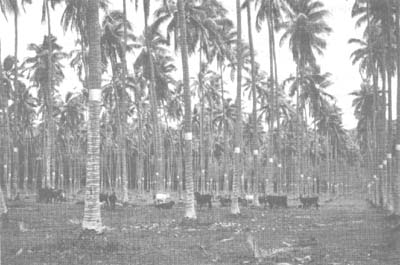
Figure 169. - Cattle grazing native pastures under old coconuts, Malekula, Vanuatu.
Table 110. - Liveweight production (kg ha-1 year-1) from different pasture systems in Vanuatu. (Mullen, 1993 after MacFarlane et al. 1991)
| 50% Shaded Pasture | Open Pasture > 70% Light | |||
| Rainfall | <1500 mm | >1500 mm | <1500 mm | >1500 mm |
| Pasture Type | coralline | fertile | coralline | fertile |
| 50% Weed Infested | 40 | 65 | 85 | 115 |
| Native Pasture | ||||
| T-grass/Legume | 70 | 120 | 160 | 225 |
| Buffalo/Legume | 100 | 170 | 250 | 325 |
| Signal/Koronivia/Legume | na | na | 400 | 500 |
Berges et al. (1993) suggest that on average productivity under coconuts is from 30–60 kg ha-1 while open pastures give around 180 kg meat carcass ha-1. They demonstrate a close correlation [y = 134.73 × -117.16 r2 = 0.77] between the stocking rate ha-1 and meat production ha-1 (see Figure 170) on the various farming systems (A to F). This was probably also a measure of the proportion of open pastures and pastures under coconuts in each system as the open pastures had higher stocking rates and higher beef production.
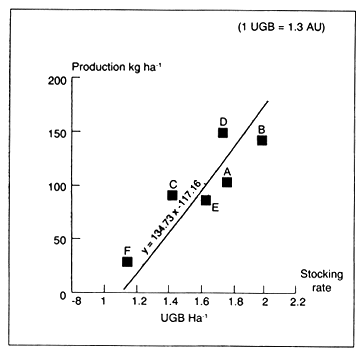
Figure 170. - Stocking rate and meat production per hectare. (Berges et al., 1993).
A comparison of liveweight gains on natural pastures without maintenance and improved pastures (P. maximum and fodder sorghum) with management indicated that in spite of the higher investment involved in improving pastures, the profits made on the improved pastures were nine times higher than those on natural pasture (Anon., 1976e).
Sheep have been successfully run on Carpet grass, T-grass and Buffalo grass plus Mimosa pudica pastures under coconuts in Vanuatu (Simonnet, 1990), at 10 ewes ha-1 in young two-year old coconuts and 6–7 ewes ha-1 in 15-year old coconuts. No damage to young coconuts was reported and the sheep controlled the M. pudica. With regular shearing (every 8 months) and avoidance of any less well drained soils foot infections were reduced and regular drenching reduced the worm burden so that mortality was reduced to only 6 percent in 1985 and 1986. Prolificacy was 160 percent, fertility 90 percent and productivity 154 percent. Mean daily weight gain between zero and six months was 178 g day-1. The sheep flock provided good weed control, without damage to the palms and first results are described as encouraging in technical and economic terms. Long-term studies are continuing (see Figure 171) to assess the effect of sheep on coconut production.
In Malaysia, most of the reported investigations have been under oil palm or rubber. Thus, Chen et al. (1978) noted under five year old oil palm spaced at 10 m × 10 m (noon light transmission 45 percent) that sown species (P. maximum and S. guianensis cv. Schofield) declined rapidly and probably have little place under oil palm just prior to canopy closure. However, one year old Kedah-Kelantan cattle at 2 beasts ha-1 make reasonable gains on native species when adequate feed is available before canopy closure. Nambiar (1991) described a system where cattle at 1 head ha-1 yr-1 were grazed under oil palm using moveable electric fencing and a rotational grazing interval of approximately 8 weeks. A substantial saving on the cost of weed control was achieved as well as revenue from meat sales.
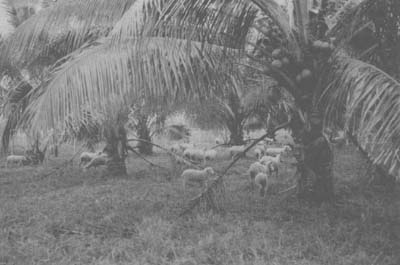
Figure 171. - Sheep grazing under young coconuts at the IRHO Research station, Santo, Vanuatu.
Idris et al. (1982) reported on the integration of Kedah-Kelantan cattle with young oil palm seedlings. The oil palm were only three months old when cut and carry plus grazing treatments (with cut and carry increasing from 6 to 24 months and grazing decreasing from 24 to 6 months with each treatment totalling 30 months) were initiated and liveweight gains, pasture composition and palm damage measurements were taken. It was concluded that cattle rearing in young oil palm areas produced reasonably good (oilpalm) pre-harvest income. Initial cut and carry methods reduced oil palm damage. Such a system could be considered for young coconut plantations. Tajuddin et al. (1993) concluded that reasonable sheep liveweight gains could be sustained in mature rubber only at the very low stocking rate of 2 sheep ha-1. Integration of sheep with fruit trees such as durian, mango and soursop with good performance has been described by Azizan et al. (1990), Hassan et al. (1992), and Khairuddin and Chen (1992).
Wong et al. (1988a) examined sheep grazing under coconut and found that mineral composition of sheep tissues and bones indicated an adequate level of mineral nutrition except for excessive accumulation of copper in the liver (1015 ppm). 60 percent of the fodder was Asystasia intrusa which contains high copper levels. Also it was noted that excessive uptake of Mikania cordata by sheep may be detrimental and cause abortion in pregnant animals (Chen et al., 1991).
Salleh et al. (1989) assessed the performance of Malin sheep under coconuts in Malaysia over a five year period and presented basic production data. Arope et al. (1985a), Bakri and Ahmad (1988); Lowe (1968); Pillai and Seeveneserajah (1988); Sibon (1988), Tajuddin (1986), Tajuddin et al. (1990), Tajuddin and Chong (1988), Tan and Abraham (1981) and Tan and Goh (1988) reviewed the Malaysian experience with integration of sheep and rubber.
Over a period of approximately one year Wong et al. (1988) noted that goats grazing on improved grasses under 18 year old coconuts (light transmission 33 percent) gained on average 46.1 g head-1 day-1 (average initial body weight 10 kg; average final body weight 22.1 kg). However, the grasses failed to persist and weed percentage increased.
Yusof and Rejab (1988) noted in Malaysia that over an 18 month period male Hereford × Kedan-Kelantan cattle on free grazing under coconuts made average daily weight gains of 242.3 g compared with gains made by animals receiving single supplements of fish meal (281.5 g), palm kernel cake (367.9 g) and copra cake (372.3 g).
Over a 368 day period Abdullah Sani Ramli and Basery (1982) recorded average daily liveweight gains of 395.4 g for yearling bulls grazed by 12 coconut smallholders on native pastures under coconuts.
Table 111. - Weight gain of cattle fed varying proportions of Setaria sp. in addition to a low-quality basal diet
| Feeding Regime (% Setaria) | Weight gain (g head-1 day-1) |
| 0 | -94 |
| 20 | 314 |
| 40 | 526 |
| 60 | 757 |
| 80 | 909 |
Note: The feeding trial was run over five weeks and the basal diet consisted of
natural grasses plus concentrates.
Source: Mahmud and Allororung (1989) quoted in Sondakh and Kaligis (1991).
A study undertaken by the Coconut Research Institute in Manado (Mahmud and Allororung, 1989) demonstrated that improvement of natural pastures under coconuts in North Sulawesi can significantly influence daily weight gain of cattle (Sondakh and Kaligis, 1991). The data in Table 111 show that greater access to planted setaria (Setaria sphacelata) pastures improves liveweight gain.
Kaligis (1993) compared average daily gain of Etawah crossbred goats on sown pastures (Arachis pintoi, centro and native grasses) and Imperata cylindrica pastures under coconut in North Sulawesi, Indonesia. On sown pasture daily gain was 0.25 kg head-1 compared with 0.10 kg head-1 on the native pasture.
Studies have been undertaken in Bali, Indonesia to determine the effect of stocking rate on liveweight gains of cattle grazing pastures under coconuts (Nitis et al., 1976; Nitis and Rika, 1978 and Rika et al., 1981). The animals used were small yearling Bali steers (see Figure 172) and were grazed at 2.7, 3.6, 4.8 and 6.3 animals ha-1. Table 112 shows liveweight gains for the periods 1974–75 (group 1) and 1975–78 (group 2). Over the three years, mean maximum liveweight gain was 135 kg animal-1 which decreased by 8.2 kg per unit increase of stocking rate (Mannetje, 1981). Liveweight gain per unit area (386 to 733 kg ha-1) was of the same order as that recorded from the preliminary grazing of block 1 (Nitis et al., 1976, 302 to 611 kg ha-1 over 254 days). Although the proportion of sown grass declined at the very end of the grazing experiment on the two higher stocking rates, generally there was little significant change of the type recorded by Watson and Whiteman (1981a) and Smith and Whiteman (1983b); the sown pasture content recovered rapidly after destocking. The authors concluded that stable pasture and animal production levels of about 550 kg ha-1 year-1 liveweight gain could be maintained with a stocking rate of 5 yearlings ha-1 with an annual change of animals (800 kg biomass ha-1 average throughout or 2 AU ha-1).

Figure 172. - Steers on the grazing trial, Bali, Indonesia.
Table 112. - Effect of stocking rate on cattle liveweight gains, Bali, Indonesia (Rika et al., 1981)
| Treatment | Stocking Rate (beasts ha-1) | Liveweight gains | |||
| Group 1 Aug. 1974-Aug. 1975 Kg head-1 day-1 kg ha-1 | Group 2 Nov. 1975-Feb. 1978 kg head-1 day-1 kg ha-1 | ||||
| Sown pasture+ | 2.7 | 0.393a | 386a | 0.248a | 541a |
| 3.6 | 0.380a | 497b | 0.245a | 714b | |
| 4.8 | 0.371a | 647c | 0.215a | 834c | |
| 6.3 | 0.320b | 733c | 0.177b | 904c | |
| Local feeding system++ | - | 0.303 | n.a | 0.166 | n.a |
Note: Values in the same column followed by different letters differ at P<0.05.
n.a. = not available.
Martojo (1978) mentions rotationally grazing cover crops in a rubber plantation in West Java where cattle made daily average weight gains of 0.73 kg (male) and 0.44 kg (female). According to Nugari (1984) the introduction of 12 head of goats ha-1 resulted in a 25 percent increase in the soil organic matter level when grazed on improved pasture under coconuts for two years.
Moog and Faylon (1991) report that in the Philippines in large coconut plantations, cattle are grazed on both improved and unimproved pastures. For example, in Albay cattle graze on fertilized Tee (or carabao) grass (Paspalum conjugatum) for fattening and finishing. Grazing is usually for 60–180 days and cattle gain 0.7–1.0 kg head-1 day-1 at a stocking rate of 1 beast ha-1. In Davao fertilized para grass (Brachiaria mutica) and guinea grass (Panicum maximum) pastures can support 3 breeder cows ha-1 yr-1. In Sorsogon buffalo grazing mature native pasture at 1 head ha-1 gained 53 kg ha-1 yr-1, and where centro was present animal production increased to 93 kg ha-1 yr-1 at the same stocking rate and 151 kg ha-1 yr-1 at 2 head ha-1. Parawan and Ovalo (1987) noted that native pasture resources in traditional coconut farms were approximately 4,000 kg DM ha-1 yr-1 and estimated carrying capacity ha-1 of native pastures under coconuts was 6 goats or 5 sheep. Average daily gains for goats and sheep were 32.8 and 39.2 g, respectively; Hitchcock (1985) reported 44.3 g for sheep from 3 to 8 months of age. In Zamboanga del Sur under coconuts sheep and goats fed partly on crop by-products showed average daily gain of 54 g and 69 g respectively (Carangal and Sevilla, 1993). On Signal grass-Centro pasture under coconuts goats had average daily gains of 61 g and sheep 56 g and 44 g for male and female respectively.
Moog et al. (1993) reported on a series of demonstration trials on improved pastures carried out under coconuts in Bicol region, one of the major coconut producing areas of the Philippines:
| Study 1 - | several groups of bulls (initial weights ranged from 220 – 226 kg) grazed signal grass at two stocking rates (1.0 and 2.0 head ha-1 over a 468 day period in 1991/2. Average daily gain ha-1 was 0.465 kg and 0.431 kg at 1.0 and 2.0 head ha-1 respectively. Total liveweight gain ha-1 was 403.4 kg (2.0 head ha-1) and 217 kg (1.0 head ha-1). |
| Study 2 - | yearling heifers and bulls grazed Signal grass at three stocking rates (1.0, 2.0 and 3.0 head ha-1) over a period of approximately eight months from late 1991. Average daily gains head-1 decreased from 0.355 kg at the lowest stocking rate of 1.0 head ha-1 to 0.203 kg (2.0 head ha-1) and 0.144 kg (3.0 head ha-1). The highest liveweight gain ha-1 of 104.49 kg was obtained at 3.0 head ha-1. |
| Study 3 - | heifers grazed Signal-Centro pastures at three stocking rates 1.0, 2.0 and 3.0 head ha-1) in two trials, 5 February-17 July 1991 and 29 January-6 June 1992. In trial 1 liveweight gain head-1 and average daily gain head-1 were highest at 1.0 head ha-1 with 60.7 kg and 0.37 kg, respectively. Highest liveweight gains ha-1 were obtained at 3.0 head ha-1. In trial 2 higher liveweight gains ha-1 were obtained from higher stocking rates. |
| Study 4 - | sheep with an initial weight of 11.8 kg were grazed at 10 heads ha-1 on pastures of Brachiaria humidicola, Paspalum notatum and Brachiaria decumbens. Over a 9 month period highest liveweight gain head-1 was obtained from sheep grazing Paspalum notatum. Animals grazing on Signal grass pasture showed poor performance with high mortality rate of 60% (although not indicated this may be another case of photosensitization - refer to 3.13 ii). |
Deocareza and Diesta (1993), recognizing that the area under coconuts in the Philippines offers tremendous potential for animal production, noting that the existing species such as Imperata cylindrica (cogon), Paspalum conjugatum (carabao grass), Digitaria sp., leguminous cover crops and various shrubs are of low nutritive value and have a low carrying capacity and realizing that most of the coconut plantations comprise ageing stands of low yielding trees and fluctuating copra prices, suggest that there are a number of options for pasture improvement (and livestock production) under coconuts:
Fertilizer application on the existing vegetation
Although the palatability of P. conjugatum is low, maximum animal production can be obtained if the grass is grazed young. If fertilized with nitrogen and cut or grazed at 20 day intervals the crude protein levels were comparable to other improved grass species. While unfertilized P. conjugatum gave average daily gains for grazing cattle of 0.31–0.46 kg, grass fertilizer with urea (46% N) at 150 kg urea ha-1 yr-1 gave average daily gains initially of 0.79 kg declining to 0.46 kg as the weed component increased under continuous grazing.
Native pasture oversown with legumes
Native pasture (Imperata cylindrica) under coconuts oversown with Centrosema and grazed at 1.0 AU ha-1 gave liveweight production of 185.25 kg head-1 over two years compared with 106.09 kg head-1 at the same stocking rate on native pastures, or 92.62 kg ha-1 yr-1 and 53.05 kg ha-1 yr-1 respectively. At 2.0 AU ha-1 liveweight gain was 151.0 kg ha-1 yr-1. Probably, Imperata pastures will only support a stocking rate of < 1.0 beast ha-1; continuous grazing at higher stocking rates will result in a decline in vigour of the Imperata and invasion of unpalatable weeds. Legume oversowing increases the feed value and liveweight gains.
Replacement of native vegetation with improved grasses
Signal grass (B. decumbens) grazed at 1.0 AU and 2.0 AU gave liveweight gains of 169.73 kg ha-1 yr-1 and 314.60 kg ha-1 yr-1, respectively over a two-year period.
Introduction of improved grass-legume mixed pastures
Signal-Centro grazed at stocking rates of 1.0, 2.0 and 3.0 gave 136.51 kg ha-1 yr-1, 147.46 kg ha-1 yr-1 and 305.5 kg ha-1 yr-1 liveweight gains.
An economic analysis of these four different approaches to pasture improvement under coconuts is given in Chapter 8.
A summary of liveweight gain data for cattle grazing pastures under coconuts is given in Table 113.
Animal productivity varied from a low of 44 kg ha-1 (Manidool, 1983) in Thailand to a high of 505 kg ha-1 (Rika et al., 1981) in Indonesia, 550 kg ha-1 in Vanuatu and a very high figure of 744 kg ha-1 (Robinson, 1981) in Western Samoa. However, it is doubtful that the gains recorded by Robinson were sustainable and the data of Rika et al. (1981) are unusually high. Shelton (1991a) notes that the variation in gains was associated with a number of management and environmental differences such as light transmission, pasture species, soil type, fertilizer strategy, animal size, and stocking rate whose relative influence is difficult to assess. However, it is clear that a number of factors can be identified:
PLANTATION PALM DENSITY AND AGE, and therefore, LIGHT TRANSMISSION is an important factor as liveweight gains were highest in the more open (and usually older) plantations where forages received the highest percentage of ambient radiation. Shelton et al. (1987a) suggest that liveweight gains under (coconut) plantations are generally considerably lower than those measured on unshaded pastures in comparable environments, although direct comparisons have not been reported. Thus, on unshaded pastures on the Guadalcanal plains of the Solomon Islands, mean animal production was 0.47 kg head-1 day-1 (607 kg ha-1 yr-1) on para grass/control pastures and 0.38 kg head-1 day-1 (442 kg ha-1 yr-1) on signal grass/control pastures both stocked at 3.6 beasts ha-1 (Watson and Whiteman, 1981b). This compares with mean values over three years under coconuts in the Russell Islands of from about 250–345 kg ha-1 yr-1 with natural and sown pastures (Watson and Whiteman, 1981a; Smith and Whiteman, 1983b - see Tables 106 and 108), although Shelton et al. (1987a) refer only to an average liveweight gain over 3 years of 0.34 kg head-1 day-1 (292 kg ha-1 year-1) on naturalized mat grass (Axonopus compressus), mimosa (Mimosa pudica) and centro (Centrosema pubescens) pastures under a coconut density of 175 palms ha-1 and light transmission of 60 percent. They suggest that lower liveweight gains from pastures under coconuts may be related to lower pasture biomass production and also to the lower nutritive value of species growing under low light conditions. Humphreys (1991) refers to studies by Smith and Whiteman (1985; 1985a) where lightly stocked pastures on the Guadacanal Plains of the Solomon Islands gave average cattle liveweight gains of 0.53 kg head-1 day-1 relative to 0.38 kg head-1 day-1 on lightly stocked pastures under coconuts.
Table 113. - A summary of cattle liveweight gain data from grazing experiments under coconuts (Modified from Shelton, 1991a and Stur et al., 1994)
| Country | Pasture | Lighttransmission (%) | Liveweight gain (kg ha-1 yr-1) | Stockingrate (b ha-1) | Reference |
| Solomon Islands (2900 mm yr-1) | natural | 60 | 235–345 | 1.5–3.5 | Watson and Whiteman, 1981b |
| improved | 60 | 227–348 | 1.5–3.5 | ||
| natural | 62 | 219–332 | 1.5–3.5 | Smith and Whiteman, 1985 | |
| improved | 62 | 206–309 | 1.5–3.5 | ||
| Western Samoa (2900 mm yr-1) | natural | 50 | 148 | 1.8 | Reynolds, 1981 |
| improved | 50 | 225–306 | 1.8–2.2 | ||
| natural | 70–84 | 127 | 2.5 | Reynolds, 1981 | |
| improved | 70–84 | 273–396 | 2.5 | ||
| natural | 70–84 | 401–466 | 4.0 | Robinson, 1981 | |
| improved | 70–84 | 421–744 | 4.0 | ||
| Indonesia (1700 mm yr-1) | improved | 79 | 288–505 | 2.7–6.3 | Rika et al., 1981 |
| Philippines (> 2000 mm yr-1) | improved | n.a. | 169–315 | 1.0–2.0 | Moog et al., 1993 |
| improved | n.a. | 130–158 | 1.0–3.0 | Deocareza and Diesta, 1993 | |
| improved | n.a. | 137–306 | 1.0–3.0 | ||
| natural | n.a. | 51 | 1.0 | Deocareza and Diesta, 1993 | |
| improved | n.a. | 91–146 | 1.0–2.0 | ||
| Thailand (1600 mm yr-1) | natural | n.a. | 44 | 1.0 | Manidool, 1983 |
| improved | n.a. | 94–142 | 1.0–2.5 | ||
| Vanuatu (> 1500 mm yr-1) | improved | n.a. | 175 | 1.5 | Macfarlane and Shelton, 1986 |
| natural | n.a. | 250–285 | 2.6–3.0 | Evans et al., 1992 | |
| improved | n.a. | 550 | 3.0 |
SPECIES - Both Reynolds (1981) and Manidool (1983) demonstrated substantial improvement in liveweight gains from improved over natural forages indicating the desirability of replacing natural with improved forages for maximum animal production (Shelton, 1991a). However, sown pastures have been reported not to persist in a number of long-term studies (Rika et al., 1981; Smith and Whiteman, 1983b; Watson and Whiteman, 1981b) and especially where light transmission is less than 50%, and several studies have noted that differences are less obvious where there is a high proportion of naturalized legume in natural pastures which clearly improved its quality for grazing animals. In Vanuatu, MacFarlane (1993) illustrated the influence of improved pastures (in the open and under shaded conditions) on liveweight gains (see Figure 173). For an investment of 8,000– 15,000 VT ha-1 (US$ 66.7–125 ha-1) on pasture rehabilitation farmers have received an additional 20,000 VT ha-1 (US$ 166.7) income.
LEGUMES - The importance of legumes to pasture quality under coconuts was also demonstrated in Vanuatu where low liveweight gains were reported for animals grazing pure Stenotaphrum secundatum pastures (MacFarlane and Shelton, 1986). According to Shelton (1991a) subsequent measurements of liveweight gains of smallholder cattle grazing buffalo grass containing the naturalized legumes Desmodium canum and Vigna hosei showed average gains of 0.7 kg head-1 day-1 over a 100 day period. MacFarlane et al. (1992) refer to a trial at IRHO on Santo where five cattle on para grass only gained weight at 444 kg ha-1 per yr-1 whereas five cattle grazing para grass with 16% legume gained 552 kg ha-1 yr-1. Differences were also given for liveweight gains on T-grass, carpet, buffalo and Koronivia pastures with and without legumes. In the Philippines, Moog and Faylon (1991) refer to a study carried out in Sorsogon where buffalo grazing mature native pastures at 1 head ha-1 gained only 53 kg ha-1 yr-1. Where the native pastures contained Centrosema pubescens animal production was 93 kg ha-1 yr-1 at the same stocking rate (and 151 kg ha-1 yr-1 at 2 head ha-1).

Figure 173. - Liveweight gain from various pasture systems at 2, 2.5 and 3.5 animal units ha-1 on fertile soils receiving > 2,500 mm rainfall year-1 (MacFarlane, 1993).
STOCKING RATE - The overall general relationship between stocking rate and liveweight gains ha-1 on improved and natural pastures under coconut is shown in Figure 174. The overall relationship is less meaningful than the individual curves fitted manually to individual trial data (e.g., for Manidool, Smith and Whiteman, etc.) because no account is taken of differences in percentage light transmission and size of animals, the importance of stocking rate in affecting production, etc. as explained in section 5.3.5.2.
Shelton (1990a) has analyzed some of the data using the stocking rate model of Jones and Sandland (1974) and details are shown in Figure 175 using data for the Solomon Islands and Thailand.
| x | Reynolds trial 2 and 4 | x | Mean of improved species | xL | Local |
| ○ | Robinson trial 1 and 2 | ○ | Mean of improved species | ○L | Local |
| □ | Watson and Whiteman | □ | Mean of 3 years improved | □L | Mean of 3 years local |
| • | Smith and Whiteman | • | Mean of 3 years improved | •L | Mean of 3 years local |
| Δ | Rika et al | Δ | Mean of 2 groups | ||
 | Manidool |  | Mean of 1979–1980 improved |  L L | Local |
| ◊ | Moog et al | ◊ | Study 2 Signal grass |
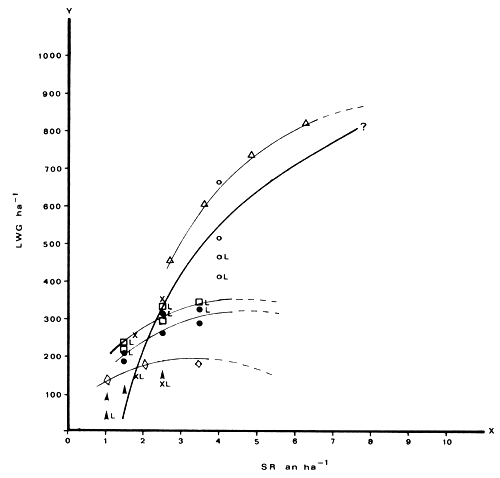
Figure 174. - The general relationship between liveweight gains and stocking rate on improved and natural pastures under coconuts.
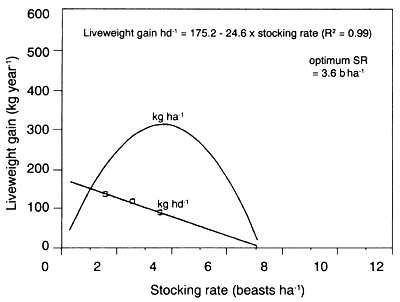
a. Solomon Islands (After Smith and Whiteman, 1983b).
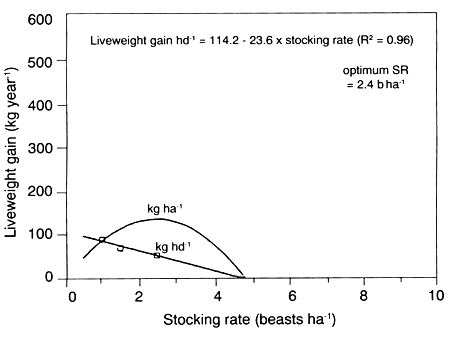
b. Thailand (after Manidool 1983).
Figure 175. - Liveweight gain and optimum stocking rate (SR) under coconuts in Solomon Islands and Thailand (after Shelton, 1991a).
ANIMAL SIZE - The liveweight gain data are influenced by various sizes of animals used in the different trials and may not be directly comparable. Thus, Rika et al. (1981) used small yearling Bali steers with initial liveweight of 97 kg, whereas Reynolds (1981) used steers of 250 kg liveweight. Zoby and Holmes (1983) indicated that small and medium sized animals achieved significantly larger daily gains than larger animals. The small animals, in comparison to the larger ones, yielded faeces with significantly lower ash and cellulose contents, while nitrogen contents were higher, which imply a greater degree of selection by the small compared with the large animals. Jones and Coates (1992) compared annual liveweight gains of steers of different ages in three grazing experiments near Townsville in Australia. The consistent ranking in liveweight gains was: weaners > yearlings > 2 year-old steers (P<0.001) clearly showing the effect of age (or weight) of steers on their liveweight gain when grazing tropical pastures. However, they stress that not all reports have shown this relationship.
Smith and Whiteman (1983b) reported that shading may reduce grass quality. Wilson (1982) indicates that although shading reduces the nutritive value of herbage it is not likely to be a major limitation for animal performance except at the level of shading experienced by pastures grown in conjunction with forestry or plantation crops. He cites the work of Hight et al. (1968) in which sheep fed perennial rye grass (Lolium perenne) pasture shaded to 22 percent sunlight ate 9–15 percent less and had daily liveweight gains 38 percent lower than those fed on pasture grown in full sunlight. Wilson suggests that this supports the comment often made (see Burton et al., 1959) that animals make poorer liveweight gains during cloudy, wet weather, although this could be due to animal rather than plant factors.
The depression of cattle growth rates during the wet season due to excessive rainfall and low radiation conditions has been reported from a number of Pacific countries (MacFarlane, 1993a). In the Solomon Islands when quarterly rainfall exceeded 1,000 mm, mean animal growth rates dropped from 440 g day-1 to 290 g day-1 averaged over three years. In Vanuatu, steers grazing para grass (+ 15% sown legume) pastures over a 7-month period from July 1990 to February 1991 averaged 780 g day-1 and 250 g day-1 over the subsequent three months when 1,600 mm of rain fell. Under such conditions incident radiation can fall to 30% fully illuminated values. In Papua New Guinea growth rate responses of 200 g day-1 from steers fed copra cake pellets have been reported and there are a number of energy supplements which could be used to overcome energy deficiencies during these high rainfall periods (which may interfere with tight delivery schedules where plantations have contracted to supply finished steers to abattoirs).
Although trial results demonstrate that good liveweight gains can be achieved from running cattle under coconuts, the major problem identified is the question of sustainability which appears to be related to the degree of persistence of species and the control of unpalatable weed infestations. Shelton (1991a) suggests that the degree of the weed problem is likely to be related to the level of management and the vigour of the pasture. Good management may involve not only the correct choice of species to plant, but also judicious weeding, fertilizer application to forages on poorer soils and control of stocking rates to maintain vigourous pastures. It is important that species used can persist under grazing and maintain sufficient vigour to resist weed invasion. It is also important that new species are identified which are better adapted to the lower light conditions of many coconut plantations or that, in establishing new coconut plantations, tree densities are adjusted to better accommodate existing species (see Chapter 10). Where there are shaded and open pastures, cows and calves are best run under shade, reserving open pastures for post-weaning growth (MacFarlane et al., 1992).
There have been a number of reviews of milk production in the tropics (Chamberlain, 1989; Smith, 1985). Environmental effects on the productivity of the lactating cow have been reviewed by Cowan et al. (1993); Johnson (1991) and Sorensen (1989) and the likely effect of increasing temperature and the temperature-humidity index on feed intake and milk production noted (see Figure 176). Chemineau (1993/4) reviewed the effect of photoperiod and heat load on animal reproduction. An expert consultation on the feeding of dairy cows in the tropics was recently organized by FAO (Speedy and Sansoucy, 1991).

Figure 176. - Milk production as related to environmental temperature (relative humidity 50%). After Sorensen (1989).
The performance of Bos taurus dairy cattle in the tropics has been extensively studied (Alves, 1967; Arganosa et al., 1989; Combellas et al., 1981; Knudsen and Sohad, 1970; Marples and Trail, 1967; McIntyre, 1971; Phipps, 1973). Although their levels of milk production are lower than those reported in temperate countries, their yields are higher than local Zebu stock (Wan Hassan et al., 1981). Average milk yields of top cattle breeds under good management standards (with protein content varying from 3.0–3.5 percent) and typical lactation periods of 280–320 days have been listed by Anon (1989b) - see Table 114.
Although McDowell (1972) reported that Friesians in Venezuela produced 4,000 kg of milk lactation-1 (and Trujillo, 1991 has indicated even higher yields) milk yields generally are lower: Friesians in Fiji - 2,964 kg lactation-1 (McIntyre, 1971); Jerseys in Malaysia - 1,672 and 2,043 kg in first and second lactations (Wan Hassan et al. 1981).
Only where improved systems of feeding and supplementation combined with high levels of management are practised will these high milk yields be obtained (Archibald, 1985; Kabuga and Agyemang, 1984; Topps, 1985). Generally, tropical pastures have lower protein, energy and digestibility levels than temperate pastures and animals will spend longer grazing (Chamberlain, 1989). According to Cowans (1975) cows grazing tropical pastures require about 10–12 hours a day of grazing to satisfy their nutritional needs. Often they are reluctant to do a lot of grazing during the day as the temperature is high. Night grazing or feeding should be encouraged in the tropical environment (Aminah and Chen, 1991).
Table 114. - Average milk yields by breed in the tropics (Anon. 1989b)
| Breed | Milk Yield (kg) | Fat Content (%) |
| Holstein-Friesian | 5000–8000 | 3,8 |
| Friesian | 5000–7000 | 4.0 |
| Meuse-Rhine-Yssel | 4000–6000 | 4.2 |
| Brown Swiss | 4000–6000 | 4.2 |
| Ayrshire | 4000–6000 | 4.0 |
| Jersey | 3500–4500 | 5.5 |
| Guernsey | 3500–4500 | 5.0 |
| Sahiwal | 1000–2000 | 4.5 |
| Red Sindhi | 1000–2000 | 4.5 |
| Tharparker | 1000–2000 | 4.2 |
| Crossbreds | 1500–3000 | 3.5–5.0 |
Berry (1985) notes that the traditional systems of milk production in developing countries are usually part of a mixed farming system and make use of crop residues and roughages. The animals return fertility to the soil, produce milk and meat and often provide draught power. Where sufficient is produced income from milk sales is of particular value as it is generated daily and more likely to be used for increasing family well-being (purchase of food) than the periodic incomes derived from other agricultural activities. Where sufficient land is available to grow forages and crop residues such as maize and bean stover, banana stems, sweet potato vines, cassava foliage and straw are available, then ‘commercialized subsistence dairying’ is likely to be practised, i.e., where milk is deliberately produced for the market. A simple model of this system is shown in Figure 177. However, Berry (1985) notes that labour is first allocated to subsistence and cash crops and only secondly to forage and animal production. Milk yields are likely to be only 30 to 50% of yields reported for similar animals on research stations or kept under more commercial conditions underlining the secondary importance attached to animal production within this system. Typical milk yields range from 500–900 kg yr-1 cow-1.
Aminah and Chen (1991) indicate that the tropical dairy breed, a Bos indicus animal, has a low potential for milk production which is between 500–950 kg lactation-1, whereas the milk production potential of the crossbred (Bos taurus × Bos indicus) is higher at 1,200–1,900 kg lactation-1 and due to feed constraints and environmental stress pure-bred dairy cows such as Friesian and Jersey will probably only achieve a portion of their milking potential at 1,150–2,200 kg lactation-1.
Ragsdale et al. (1948) had demonstrated how feed consumption declined with increasing thermal stress and studies by Johnson (1980, 1987) and Johnson et al. (1961, 1987) confirmed feed intake and milk yield declines with increases in the temperature-humidity index. According to Beede and Collier (1986) the food intake of the Holstein-Friesian cow begins to decrease at ambient temperatures above 26°C. Goldson (1963) and Cowan (1975) showed cows markedly reduced the amount of grazing done during the day in summer, with 26°C being the point at which this begins to occur. When the temperature was above 32°C little effective day-time grazing was done. McIntyre (1967) in Queensland had concluded that as long as cows were able to cool down at night the effects of high day temperatures on milk yields would be negligible. Management systems in which animals in Nigeria were allowed to graze at night (Breinholt et al., 1981) resulted in an improvement in milk production associated with increased feed intake during the hours of darkness. Similarly provision of shade, cold water and sprinkler systems which reduce the ambient temperature, will aid milk production (Igono et al., 1987; Johnson et al., 1987; Parker, 1984; Roman-Ponce et al., 1977; Wiersma et al., 1984). Davison et al. (1988) demonstrated in northern Queensland that cows with access to shade had significantly higher milk yield than cows without shade.
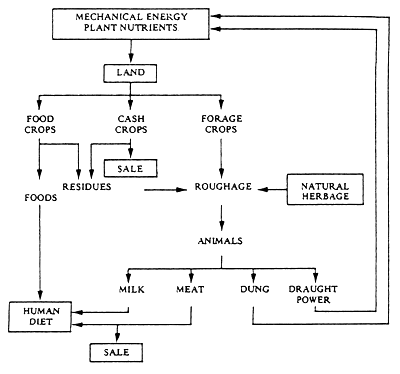
Figure 177. - A diagrammatic representation of the commercialised subsistence dairying system (after Berry, 1985).
In the trials from Malaysia reported by Wan Hassan et al. (1981), the Jerseys were housed in sheds during the hotter part of the day and grazed on Brachiaria decumbens and Setaria splendida pastures in the evenings and nights.
Data on performance of dairy cows on pastures under coconuts are more limited. In Sri Lanka, where Malkani (1951) commented on dairying under coconuts, great effort has been devoted by the Coconut Research Institute to improving the small local Sinhala cattle for milk production in order to increase the income ha-1 on coconut lands. Goonesekara (1967) showed that a Jersey-Sinhala cross was much more productive than pure Sinhala, and Buvanendran and Mahadevan (1975) suggested that Friesian-Zebu (Sindhi or Sinhala) crosses were more suited to the coconut triangle and Jersey crosses to the dry zone. Milk yields of <500 kg for the Sinhala were compared with yields of 1000–1900 kg per lactation for the crosses.
Liyanage (1983) confirmed that the Sinhala/Jersey cross has proved to be more productive in terms of the efficiency of converting herbage into milk and therefore is the most suitable for raising under coconut plantations, where Cori grass (Brachiaria miliiformis) and B. brizantha combined with legumes such as Centrosema pubescens are usually maintained in mixed swards while Panicum maximum and hybrid Napier NB21 are the main fodder varieties. It was estimated that four milk cows could be maintained on one hectare of coconut land intercropped with improved pasture and fodder varieties.
Jayawardana (1988) indicated that the indigenous × Jersey × Sindi cross cow, that is recommended for the Coconut Triangle, is expected to produce 4–5 l of milk day-1 at peak lactation on well managed improved pastures with feeding supplements.
Surveys carried out by Richards and Agalawatte (1981) provided comparative data (see Table 115). The European breeds were more profitable than Sinhala cattle. Only in the coconut triangle was feeding of concentrate profitable at levels above an equivalent of about 1 kg coconut poonac per day. In Sri Lanka where over 75 percent of holdings are <1 ha in size, 30 percent of the herds contained < 5 animals. The management system used was stall feeding and tethering with and without supplementary cut grass.
Recently, Jayarwardana (1992) suggested that if pasture development was intensified, it could support a five fold increase in milk production on coconut lands in the higher rainfall areas of the Coconut Triangle.
Table 115. - Comparison of herds on a milk yield basis in Sri Lanka (Richards and Agalawatte, 1981)
| Herd | Milk Yield (I) | |
| annual | per lactation | |
| Sinhala | 223 | 269 |
| European cross | 1,006 | 1,257 |
| Indian cross | 474 | 758 |
In trials conducted by Chadhokar (1983c) on the effects of dry season Gliricidia supplementation milk yields averaged 5.7 to 5.9 kg cow-1 day-1 for Maas Kyn Yssel (Netherlands) imported cows in the Mid-Country region.
Childs and Groom (1964) reported a doubling of milk yields from about 340 l per lactation for local milk cows in the Tanga region of Tanzania when bushes and undergrowth were cleared from under coconuts and better quality grasses such as Cynodon dactylon and Panicum spp replaced weeds and unpalatable species.
Mahadevan and Hutchison (1964) studied the performance of crosses of Bos taurus and Bos indicus cattle for milk production in the coastal region near Tanga and found that average lactation milk yield ranged from about 1000 l for Bos indicus animals to 1900 l for half-bred Bos taurus. Kiwuwa (1972) reported mean lactation yields of 1264 kg milk for Tanga East African Zebus, while Kimenye (1982) indicated milk yields of 1050 kg for Boran/Jiddu cows in the same area.
Goldston (1980) carried out a series of experiments in the coastal zone of Kenya and concluded that milk production from pastures under cashew could equal that from open pastures (although it appeared that pasture availability was not a limiting factor in the experiments). The main beneficial effect of the cashew trees appeared to be the provision of shade and comfortable conditions for the animals, under which they could spend a longer grazing time (Torres, 1983). However, there were no significant differences between milk yields in four treatments with and without shade during the wet and dry seasons (Goldston, 1973).
Osman and Ahmad Mustaffa (1978) reviewed the potential for incorporation of dairy cattle into coconut smallholdings in Malaysia, in order to improve the living standard of coconut farmers. It was noted that the animals were allowed limited grazing and the cut-and-carry system was practised. Hassan et al. (1989) experimented with 1 ha diary units over a four-year period and concluded that smallholder dairy units in Malaysia could be economically viable and competitive with other agricultural enterprises, such as rubber and oil palm. Soetrisno et al. (1986), noting that milk production from imported Sahiwal-Friesian cows was anticipated to be greater than the average yields of 2.8–5.4 kg day-1 over 180–345 days recorded for the existing Local Indian Dairy (LID) cattle and their crossbreds, recorded production levels of 10.2 kg day-1 for grazed cows and 8.4 kg day-1 for stall-fed cows. The 20% higher milk production of grazed animals (Setaria sphacelata var. splendida) was a direct result of the superior quality of forage available compared to the Panicum maximum-Pennisetum purpureum available to the stall-fed animals. Concentrate was fed to both groups at one kg for every 2.5 kg of milk produced. It was concluded that Sahiwal-Friesian cows are suitable for smallholder milk production under either grazing or stall-feeding provided nutrition is adequate. Wong et al. (1987) carried out an experiment at MARDI to determine the potential milk production of Sahiwal-Friesian cows under two management systems: stall feeding and rotational grazing on Leucaena - B. decumbens mixed pasture with supplemental feeding. Rotational grazing was better than stall feeding for milk production. In the stall feeding system milk production was 8,577 kg ha-1 lactation-1 while rotational grazing without supplements yielded 9,180 kg ha-1 lactation-1 and supplementation at 4 and 6 kg concentrate cow-1 day-1 increased milk production to 13,323 and 17,070 kg ha-1 lactation-1 respectively.
Moog (1991) noted that smallholder dairy farmers in Philippines raising Sahiwal-Holstein Friesians feed their animals with 5–19 kg fresh Ipil-ipil (Leucaena) leaves in combination with fresh grass fodder and obtain 4–7 kg milk cow-1 day-1. The leucaena is planted in hedges around the home-lots and farmlots, and in evenly spaced rows (1–2 m) under coconuts.
Sophanodora and Tudsri (1991) stress that the use of improved pasture species and good management can dramatically raise animal production under tree crops. The usual carrying capacity of native pastures is 1–2 ha animal-1. A diary farmer in Pakchong, Thailand grew 1 ha of guinea grass (Panicum maximum) between rows of mango trees, applied 125 kg ha-1 of urea and cut the grass every 30–40 days; this produced enough feed for 8 diary cows which produced an average of 10–12 l milk day-1. The returns from milk alone were approximately 500 Baht day-1 (US$ 19.76).
The need to provide shade for dairy cattle in the tropics has been stressed by a number of workers (Davidson et al., 1988; Frazer, 1974; Lemerle and Goddard, 1986; McDowell, 1972; Richards, 1985; Schultz, 1983; Sorenson, 1989). In Tanzania, MacFarlane and Stevens (1972) demonstrated that coconut shade had a very significant effect on Friesian crosses (increasing milk yield by 18.4 percent) but no significant effect on Borans. However, in Thailand, Hongyantarachai et al. (1989) found no difference in milk yields (which averaged 14 kg cow-1 day-1) between crossbred cows (Holstein/Friesian and Red Dane) kept indoors in a shaded cowshed during the day and those kept outdoors. In fact, milk fat percentage was higher (and mastitis infection lower) in cattle grazed outdoors for 24 hours. Pastures were Guinea grass and Verano stylo and all cows received some 9–10 kg of concentrate cow-1 day-1. This finding would tend to support McIntyre (1967) who concluded that provided cows are able to cool down at night the effects of high day temperatures on milk production would be negligible.
A considerable body of data on milk production by different cattle breeds in tropical areas is summarized in the volume of working papers from the expert consultation on dairy cattle breeding in the humid tropics (Anon., 1982b), but most of the yields relate to cows fed supplements. Crowder and Chheda (1982) also reviewed in some detail the effect of supplements on milk production on tropical pastures. Wellington (1982), reviewing the breeding programme for dairy cattle in the Caribbean, indicated that milk production levels have reached 4000 kg in Barbados and Puerto Rico, but only with high levels of concentrate feeding. Performance of purebred and grade Holstein cattle showed milk yields ranging from 1700 kg in St. Kitts to 4050 kg in Barbados and Puerto Rico. However, without concentrates Jamaica Hope cows and Holsteins gave much lower mean lactation yields when grazing fertilized and irrigated Pangola and Guinea grass (see Table 116).
Table 116. - Performance traits of Jamaica Hope and Holstein cattle on a non-concentrate diet at Bodles Jamaica, 1976–78 (Wellington, 1982)
| Jamaica Hope | Holstein | |||
| Lact. 1 | Lact. 2 | Lact. 1 | Lact. 2 | |
| Mean lactation milk yields (kg) | 2,021 | 2,174 | 1,948 | 1,912 |
Anon. (1971a) reported that in terms of productivity under coconuts Guinea grass was far superior to Pangola, the latter being only a little better than natural pasture. This is not unexpected as Pangola is not a very shade tolerant species. Number of cow grazing days acre-1 year-1 for Guinea, Pangola and natural pasture were 245, 128 and 113 days respectively.
Walker (1992) describes a farm in the Seychelles at Anse Forban, where under coconuts “there was a good pasture of Stenotaphrum secundatum and very good naturalized legumes Desmodium canum, D. ascendens, D. auriculatum and D. triflorum. The cattle were tethered and grazed most of the day and no additional grasses were fed. Milkers received about 2 kg day-1 of concentrates. Production was 25 litres from three cows. This area could be further improved by applying the correct fertilizers”.
In Tonga many of the 500 Friesian-Holsteins (see Figure 178) are grazed on pastures under coconuts (mainly B. decumbens, B. mutica and local species). The average daily milk production per cow is around four litres, varying from 2.6 litres on a poorly managed farm to 8.3 litres on the best farm. Only on the farm with the highest milk yield of 8.3 litres cow-1 were concentrates fed (Uotila, 1992). Earlier in 1988 Thompson (1988) noted that milk production from the dairy herds at Liahona and Hango Colleges averaged around 4–5 l cow-1 day-1. “However, at Liahona this has been increased to 9 l cow-1 day-1 largely as a result of cows having access to more feed. Some cows in this herd have a daily production of 15 l cow-1 day-1 so there is considerable scope with herd recording, to lift the average daily milk production figure”.
In Western Samoa Friesians grazing under coconuts (at the Samoa Methodist Land Development farm - see Figure 179) averaged 3.36 kg milk cow-1 day-1 for the first 5 months of 1983 (Faamoe, personal communication). Friesians and Jerseys grazing under old coconuts spaced at 8 m2 in Zanzibar, Tanzania, produced on average 4–5 I cow-1 day-1 and approximately 1200 I per lactation (Lund, personal communication).
These yields may appear low but tropical pastures, whether under coconuts or not, severely limit high milk yields per cow (Hamilton et al., 1970; Whiteman, 1980). Milk production from tropical pastures was reviewed by Stobbs and Thompson (1975) who noted that although well fed Bos taurus cattle and their crosses are capable of high milk production in the tropics, milk production from unsupplemented improved pastures is markedly lower than from temperate swards fed at a similar stage of growth (see Table 117).
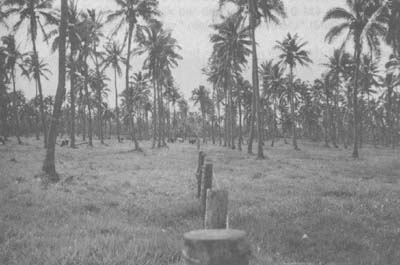
Figure 178. - Friesian-Holstein dairy cows grazing Signal grass, Tonga.
Table 117. - Digestibility and productivity of temperate and tropical pastures (Stobbs and Thompson, 1975)
| Diet | DM digestibility | Max. milk production Kg cow-1 lact.-1 | Beef production liveweight gain kg day-1 |
| Tropical pasture | |||
immature | 60–65 | 1,800–2,200 | 0.7–0.9 |
semi-mature | 50–55 | 1,000–1,400 | 0.4–0.5 |
| Temperate pasture | 70–80 | 3,300–3,800 | 0.9–1.2 |
| Concentrate ration | 80–85 | 4,400–4,900 | 1.2–1.4 |
High milk yields per hectare > 15000 kg have been reported from heavily fertilized, irrigated pastures with high stocking rates (Colman and Holder, 1968; Thurbon et al., 1973) but carrying capacity is much lower on grass-legume pastures with milk yields of between 5000 and 8000 kg ha-1.
There have been several reports from the tropics which suggest that the maximum level of milk production that can be obtained from unsupplemented tropical pasture is about 8–9 kg cow-1 day-1 (Stobbs and Thompson, 1975; Stobbs, 1975, 1976, 1978). Experiments to develop smallholder dairy units in Malaysia tended to support this (Wan Hassan et al., 1989). Chin (1993) noted that as the forage quality on offer improved by grazing younger pastures so the average daily milk yield per lactating cow (mainly Sahiwal-Friesian crosses) increased from < 5 to > 6 litres in one herd and from < 7 to > 7 litres in another herd. However, Archibald (1985), while agreeing that 8–9 kg cow-1 day-1 applies to Jerseys, notes that reviewers accepted that 12–14 kg milk cow-1 day-1 could be obtained from larger breeds such as Holstein-Friesians grazing tropical pastures as the sole diet. Stobbs and Thompson (1975) in fact recognized as more realistic an average annual yield per dairy cow of 2,000 kg from improved tropical pastures.
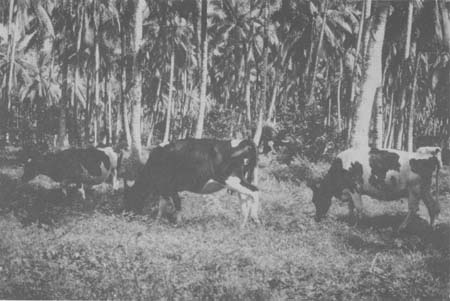
Figure 179. - Friesians grazing under coconuts at the Samoa Methodist Land Development Farm, Upolu, Western Samoa.
Cowan et al. (1975) indicated that in northern Queensland Jerseys averaged 9.1 kg of milk per day and Friesians 12.5 kg when grazed on good glycine (N. wightii), Green Panic (P. maximum var trichoglume) pastures at stocking rates of 1–1.3 cows ha-1 (without supplementary feed). The Friesians maintained their lactations for 331 days yielding a total of 4140 kg of milk. But the Jerseys dried off much earlier (at 272 days) to give a total of only 2480 kg of milk. Average yields were usually in the range 5–9 kg cow-1 day-1 (compared with milk yields up to 25 kg cow-1 day-1 on temperate pastures with long term averages of 15–20 kg) because of the limitation of low intakes of digestible energy. Stocking rate experiments demonstrated that higher yields can be achieved by accepting lower production per head from more animals per hectare. In the case of the Glycine-Green Panic pastures, the suggested stocking rate was 1.6 cows ha-1, producing 3345 kg milk cow-1 lactation-1 without supplementation. At higher stocking rates the legume component declined rapidly. Thus good management of pastures under coconuts should aim to maintain a high legume content if good milk yields are to be achieved and sustained.
Anaman and McMeniman (1990) used on-farm production data from 1980–1987 to determine the expected net present value of income from a milking cow during its lifespan for several breeds of dairy cattle in the Darwin area of the Northern Territory, Australia. The results indicated that the Australian-Friesian-Sahiwal crossbred produced the highest mean net income, followed by the Holstein-Friesian pure breed. The other breeds (including Australian Milking Zebu and Jersey) were unprofitable.
Santhirasegaram et al. (1970) demonstrated differences in nutritive value of grasses in terms of milk yields (see Table 118).
Fernandez-Baca et al., (1986) reviewed experience in Mexico with milk and beef production from tropical pastures.
Data on milk/beef production comparison, given by Mannetje (1981), is clear evidence of the high energy required for milk production. In fact, “a dairy cow weighing 500 kg and producing 20 kg of milk per day requires 110 MJ net energy, but a steer weighing 300 kg and gaining 1 kg day-1 requires only 45 MJ” (McDonald et al., 1973).
Table 118. - Effect of species and added nitrogen on milk yields (Santhirasegaram et al., 1974; Whiteman, 1980)
| Species and treatment | Milk yield | |
| kg cow-1day-1 | kg ha-1 | |
| Hyparrhenia rufa | 5.53 | 2,476 |
| H. rufa + 50 kg N after each grazing | 5.32 | 2,069 |
| D. decumbens + 50 kg N | 4.76 | 2,136 |
| B. decumbens + 50 kg N | 5.08 | 1,750 |
In view of the limitations of tropical pastures, Whiteman (1980) questions the expense and effort necessary for the importation of high yielding temperate dairy breeds and implementing cross breeding programmes. Their potential can only be achieved by supplementation with valuable grains and by-products. He suggests that there is greater advantage in a sound development of tropical pastures which might match more closely the genetic potential for milk yield of locally adapted breeds. While this is true, there remain in many tropical countries large untapped sources of by-products that could be used to boost both beef and milk production (see Chapter 6).
From the data presented it is clear that at least under the high light conditions of old coconut plantations (with > 75% light transmission), liveweight gains and milk yields are comparable with, although somewhat lower than those from legume-based pastures under open conditions. Under shady conditions (where light transmission is < 75%) yields will be much reduced. However, it should be appreciated that much of the data quoted so far were obtained from trials and experiments; generally there are many reasons for production levels to be lower when related to farmer level (Anaman and McMeniman, 1990; Combellas et al., 1981). Thus, for example, in Indonesia it was noted that soybean yields in farmers fields were generally much lower than those indicated by research station trials. In 1985, the yield on farmers' fields was only 0.9 t ha-1 compared with 2.0 t ha-1 on research plots (Anon., 1988a). In some areas where crops and animals are integrated, evidence suggests that farmers set their stocking rates at a level well below the optimum determined in district experiments (see Figure 180). Because of rainfall variability and difficulty of stocking and destocking when required farmers may prefer to use lower stocking rates although achieving lower total liveweight gains and milk output. Dillon and Hardaker (1993) suggest that due to non-transferable technology and environmental differences there will always be a difference in yield per unit of area between the high yields obtainable on research stations and the best potentially achievable yield on farms (and also between actual farm yields and the best potentially achievable yields due to biological and socio-economic constraints).
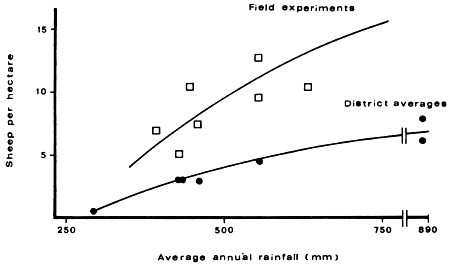
Figure 180. - Stocking rates on sown pastures in relation to rainfall: field experiments compared with district averages, (Allden, 1982; from Rossiter and Ozanne, 1970).